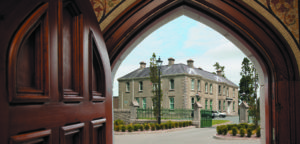MASS FOR MOTHER TERESA OF CALCUTTA
ST PATRICK’S CATHEDRAL, ARMAGH
SEPTEMBER 10, 1997 7.30 P.M.
ADDRESS BY MOST REVEREND SEAN BRADY
On this day fifty-one years ago, 10 September 1946, Mother Teresa was travelling by train north from Calcutta to Darjeeling, in the foothills of the Himalayas. Suddenly she had the inspiration to found a New Order and devote herself to the poor. Last year, fifty years later, Mother Teresa came to Armagh to open the 563rd house of that New Order – The Missionaries of Charity. She came here to this Cathedral to pray in thanksgiving. At the end of the prayers, helped by two of her Sisters, the tiny frail 85 year old lady struggled to her feet. I said struggled because as a result of an accident she had sprained her ankle and was in a wheelchair. She spoke to us then about prayer and love, two topics which were dear to her heart.
I suspect that if she were here tonight she might return to those same subjects. She certainly would not wish this sermon to be a eulogy of herself. In 1971, when Malcolm Muggeridge wrote, “Something Beautiful for God”, Mother Teresa asked that it should not be a biography of herself. “The work is God’s work”, she would say, “so all of us are but His instruments who do our little bit and pass by. We are only pencils in the hand of God”.
Mother Teresa has died after an extraordinary life. Very many people feel a great sorrow and a great sense of loss at this time. For the abandoned and the outcasts, the little ones and the forgotten ones, she was a great sign of hope. They have lost a faithful and wholehearted friend.
The greatness of Mother Teresa came from her close union with Jesus Christ. That union was nourished and strengthened by hours of prayer every single day of her life. Every morning you would find her in her convent at prayer before 5 a.m. There she knelt for hours on the ground without seat or kneeler, deeply absorbed in conversation with Jesus. I last saw her on July 1st. She was not well enough to come to Chapel, so Holy Communion had to be brought to her in the infirmary. There she was with her bible and her prayer book, in deep recollection, preparing for the coming of her Lord and Master.
Some of you may remember that in Armagh that evening her Sisters gave out little prayer cards. “Mother’s business cards”, they called them. The card read like this:
“The fruit of silence is prayer,
the fruit of prayer is faith,
the fruit of faith is love,
the fruit of love is service,
the fruit of service is peace.
Mother Teresa wrote that prayer out of her own experience. Silence, prayer, faith, love, service, peace, sum up her whole life. It is in the silence of the heart that God speaks. We need to listen to God. It is not what we say but what God says to us in prayer and through us that matters.
Mother Teresa is associated with feeding the hungry. “I was hungry and you gave me to eat”, was one of her favourite scripture passages. She knew well that there are different kinds of hunger in different parts of the world. There is the emotional hunger of those who are starved of love and affection. There is the spiritual hunger of those who are famished for want of purpose and meaning in life. She wanted to tackle those hungers as well. So she opened a house for Contemplative Sisters in New York. Their vocation is to pray most of the day. “Prayer feeds the soul”, she said, “As blood is to the body, prayer is to the soul. Prayer brings you closer to God”.
In the life of the Missionaries of Charity, more importance is given to prayer than to the actual work, but their work flows from their prayer life. Prayer puts people in touch with God and makes them capable of being His instrument. Prayer teaches us to look contemplatively at the world and to see there the living presence of Jesus. The Missionaries of Charity begin their day with prayer, both personal and communal, followed by the Eucharist, which is the real centre of their existence. Each evening they have an hour of adoration. The Sisters have a rule of reciting the rosary when travelling or while walking through the streets. Everything is done in an atmosphere of prayer.
LOVE
The source and strength of Mother Teresa’s whole life was the twofold commandment of love of God and love of neighbour. These two commandments cannot be separated. The fruit of faith is love. The Missionaries of Charity base their whole life on these two pillars, love of God and love of neighbour. They take a vow of wholehearted free service to the poorest of the poor. Every morning they recite this prayer:
“Make us worthy, Lord, to serve our fellow-men throughout the world who live and die in poverty and hunger. Give them, through our hands this day, their daily bread and by our understanding love give peace and joy”.
What is the legacy of Mother Teresa? The question has been asked often in recent days. She has left us the wonderful example of her life. It was a life so filled with the love of God that she was totally devoted to helping those in pain, those in greatest need, those who live in the slums, those who die in the streets. This love is not patronising, for charity is not about pity, it is about love. So many people admired Mother Teresa because she lived a Christianity they could accept and identify with. She inspired so many people to imitate her and has challenged them to rise to tremendous heights of generosity and self-giving. “Give till it hurts”, she said. She died possessing two saris and a pail in which she washed.
Mother Teresa is a prophet for our times and of course like all prophets she is sometimes misunderstood. She speaks a language that a lot of people don’t understand today, the language of humility and mercy for example, which is not so popular in a world which sometimes prides itself on being abrasive and assertive. She stands for reverence and respect. Respect for the weak as well as for the strong. Respect for all of God’s children, regardless of who they are. She teaches us to be patient with the patience of God himself who walks our roads with human footsteps.
Mother Teresa was a great symbol of hope because she brought love and help to those who were shunned and abandoned. She was a real missionary of charity, someone sent to tell us of God’s unconditional love for each one of us. She knew well that this love was revealed by Jesus Christ. It continues to be revealed by those who listen to his words. “As long as you did it to one of these, the least of my brethren, you did it to me”. Mother Teresa reminds us of God and of God’s claims on our love and on our time.
DEATH
Last week death took two remarkable women, Diana, Princess of Wales and Mother Teresa. They had met in life and become friends. Now they are joined in death. This evening we pray that they be united in the happiness of heaven. There is a sign on the door of the morgue of the house for the dying in Calcutta. It reads, “I am on my way to heaven”. An older lady once said to Mother Teresa, “I am full of fear. I am afraid of death. You can help me for you have seen many people dying”. Mother spent time with that fearful lady and talked happily about death. She explained her vision of death as going home to an always loving Father. The woman thanked her for comforting her by removing some of her fear. One of the great crosses in Mother Teresa’s life was the fact that due to the situation in Albania she was unable to see her own mother for many years before her death. “We will meet in heaven”, she would say. We believe that those who enter into a relationship of friendship with Jesus and love one another, here on earth, already possess eternal life and that Heaven is the fullness of that life.
May our prayer this evening deepen our own faith in the reality of life after death. May our reflection on the lives of those who have gone before us prepare us for our own death. May it inspire us to see and to serve Jesus and the least fortunate. The fruit of service is peace. May our loving service help those for whom we have prayed to enter into the fullness of everlasting life, Amen.



You must be logged in to post a comment.